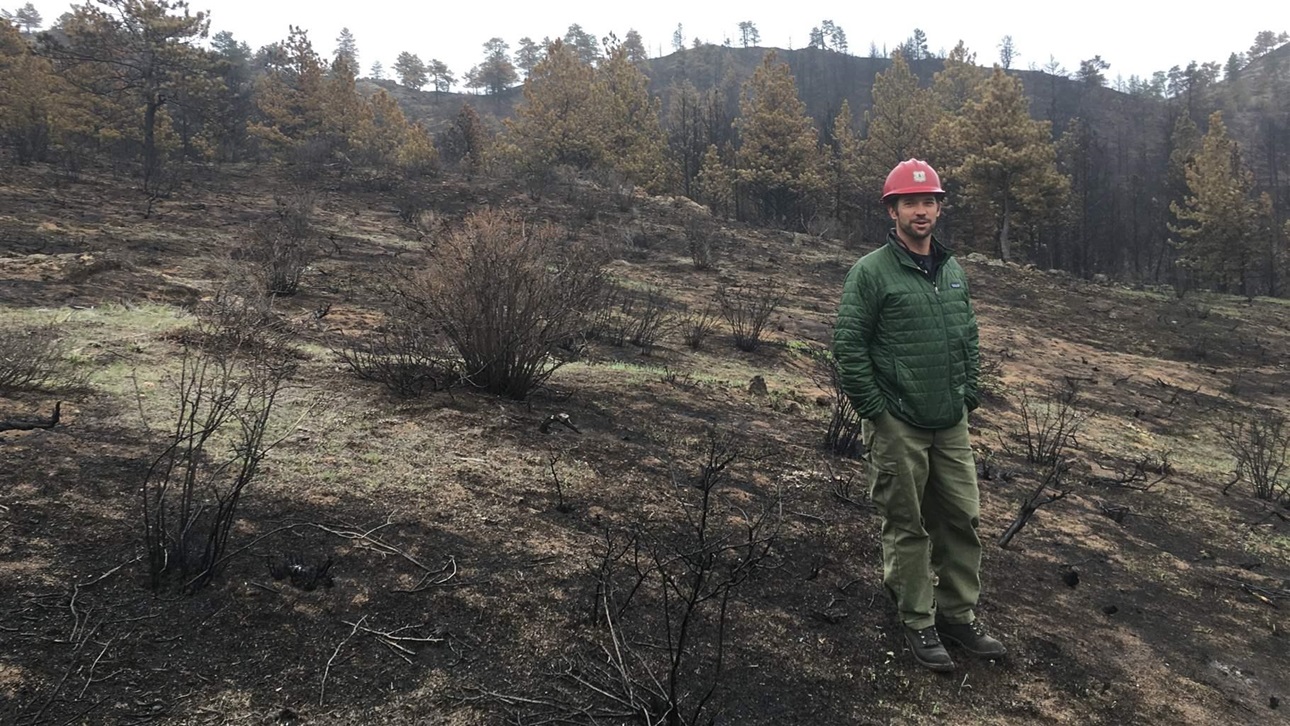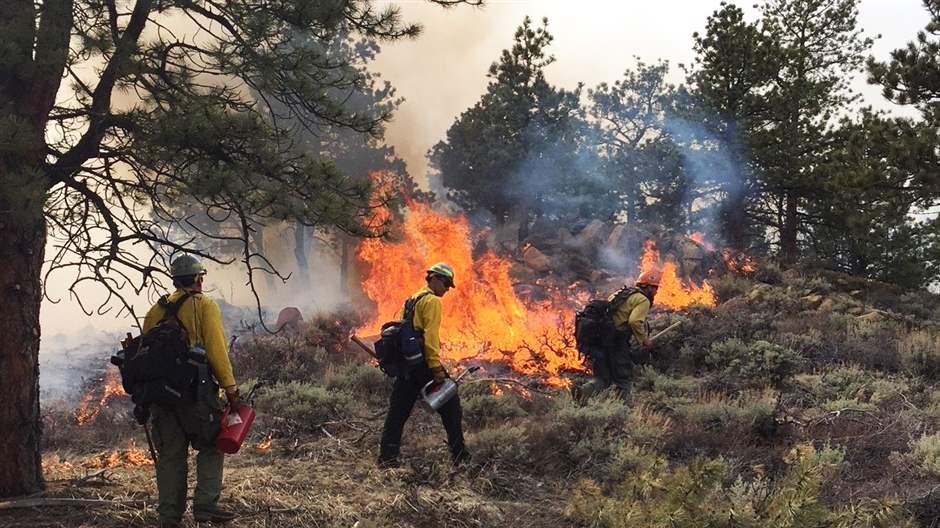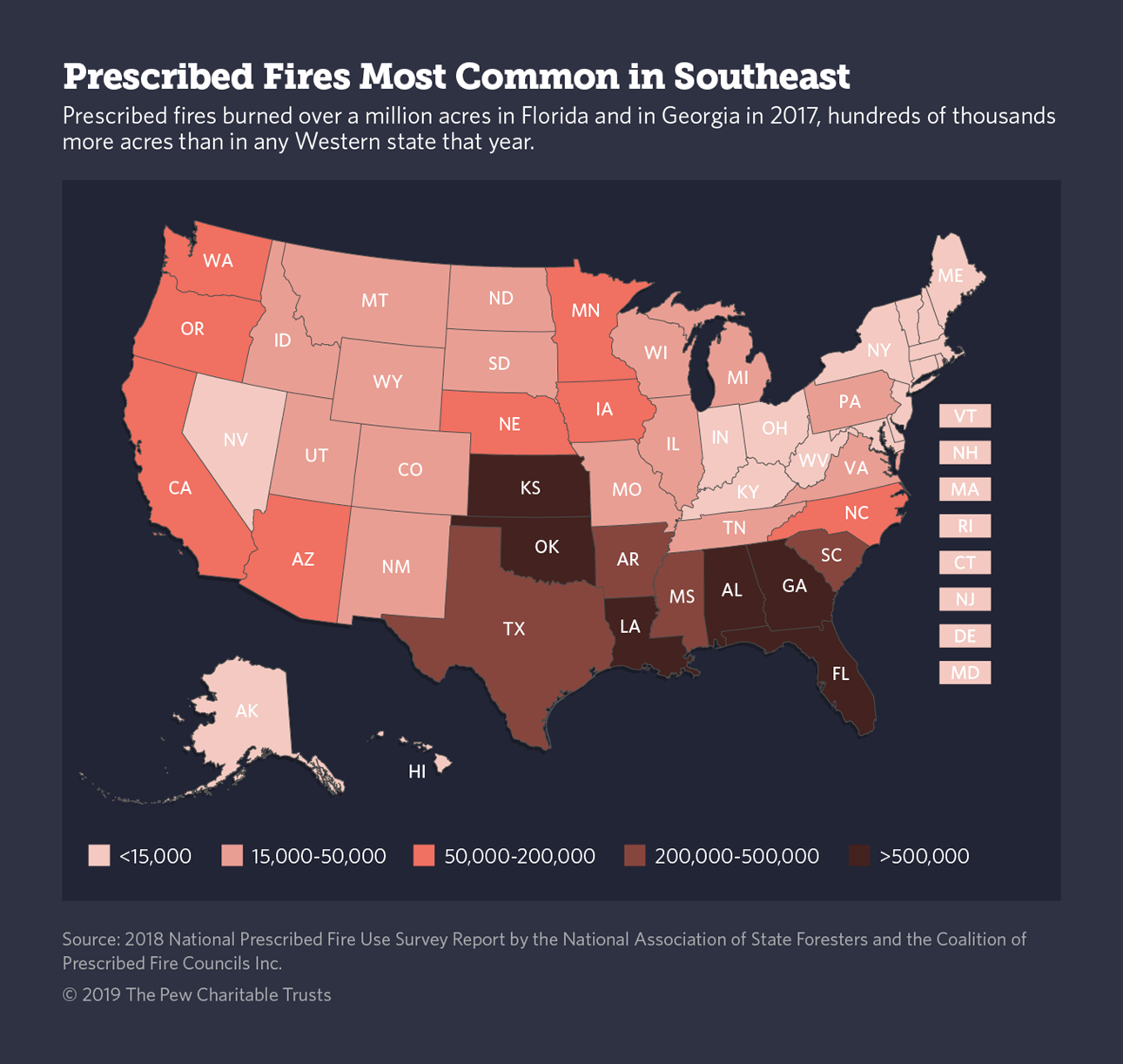Connecting state and local government leaders
Prescribed fires were burned on over 3 million acres in Western states in 2017.
RUSTIC, Colo. — Tramping over a charred mountainside here one foggy morning, Matt Champa glowed with satisfaction. “Deer and elk will love this,” said the U.S. Forest Service “burn boss,” gesturing to a cluster of blackened trees that eventually will fall and create more space for forage plants.
Champa and his team set fire to this area last month, part of the 1,900-acre Pingree Hill prescribed burn on the Arapaho and Roosevelt National Forests and Pawnee National Grassland to improve wildlife habitat and create space that firefighters could use to defend nearby residents and the Cache la Poudre River from a wildfire.
The Forest Service and its partners hope over the next decade to carry out a series of such prescribed burns in Northern Colorado to protect communities and the river, which supplies water to about 300,000 people.
Public and private landowners across the West are increasingly using prescribed fire to reduce wildfire danger. Over 3 million acres were treated with prescribed fire in Western states in 2017, up from the roughly 2 million in 2011, according to a survey by the National Association of State Foresters and the Coalition of Prescribed Fire Councils Inc.
But mountains, a dry climate and air pollution concerns make it difficult to safely set the region’s forests on fire. Burn bosses who manage prescribed fires struggle to assemble teams because federal, state and some local firefighters qualified to work on a burn could leave anytime to fight a wildfire elsewhere.
And controlled burns can be unpopular, even dangerous. After a 2012 Colorado State Forest Service burn sparked a wildfire near Denver that killed three people, then-Gov. John Hickenlooper, a Democrat, suspended prescribed burnings.
Yet experts who study public lands say low-intensity, controlled fires are a crucial tool for reducing wildfire risk — particularly as more people move to forested areas and climate change fuels hotter, drier summers. Controlled fires can quickly and inexpensively clear out large swaths of trees and undergrowth and create a better environment, over the long term, for native plants and animals.
“Prescribed fire is a critical tool, because it’s the most effective way to reduce fuels to make people and communities safe,” said Brett Wolk, assistant director of the Colorado Forest Restoration Institute at Colorado State University. “It also is the only way to restore ecological processes in the forest,” he said, such as removing debris on the surface and creating opportunities for new plants and trees to grow.
Nationwide, however, the cost of fighting wildfires has for years crowded out federal funding for other forest activities, including prescribed fire. Congress last year created a wildfire disaster fund that should help address the problem starting in 2020.

Although President Donald Trump has called for more fire mitigation work, he didn’t propose substantially more funding for it in his latest budget.
Colorado spent $40 million putting out wildfires in 2018, but the state forest service spent about $7 million on work that would make forests healthier and could reduce a wildfire’s intensity.
“If we don’t resolve how we invest our funding, and we continue to try to suppress our way out of the issue, we’re not changing anything,” said Jonathan Bruno, senior operations director for the Coalition for the Upper South Platte, a nonprofit based in Lake George, Colorado. “We’re literally just throwing water on the hot stuff — and doing it again and again.”
Fighting Fire With Fire
Years of increasingly destructive wildfires have state, federal and private landowners asking what they can do to reduce fire risk.
Northern Colorado environmentalists and foresters redoubled their efforts to push for more tree thinning and prescribed fire—treatments that often happen in sequence, with fire clearing away debris left on the ground after men or machines cut down trees and brush—after major wildfires swept the state in 2012.
Over 5,000 fires ignited in Colorado that year, including the devastating Waldo Canyon fire near Colorado Springs. In Northern Colorado, the High Park wildfire torched more than 87,000 acres along the Cache la Poudre River, destroying more than 250 homes and setting the stage for widespread flooding the following year. Ghostly, blackened tree trunks still cover many of the mountainsides along the river.
The High Park and Hewlett Gulch fires spurred the creation of the Coalition for the Poudre River Watershed, a nonprofit focused on reducing wildfire risk and keeping the river and its tributaries healthy.
Now the group is teaming up with the Nature Conservancy, local government agencies and the Forest Service, among others, to launch a partnership focused on identifying, planning and implementing prescribed fire treatments in the area.
“There has been an evolving and growing conversation around prescribed fire,” said Jen Kovecses, the coalition’s executive director.
While cutting down trees and brush helps thin the forest, she said, controlled burns can treat larger areas faster. Plus, she added, “wildfire is actually a key ecological process.”

Western forests evolved to regularly burn and regenerate, but decades of policy focused on putting out wildfires has helped foster overgrown forests of dense, thin trees—fuel for massive, high-intensity fires.
Prescribed fire experts try to ensure burns don’t blaze out of control. Accidents such as Colorado’s Lower North Fork Fire are “extremely, extremely rare,” said Mark Melvin, chairman of the Coalition of Prescribed Fire Councils. While his group doesn’t collect data on prescribed fires that escape, he said, he can’t think of another fire that killed anyone.
Champa’s team prepared the final Pingree Hill burn area by cutting down some trees, lopping off low-hanging tree limbs, and digging a dirt track or a fire line to contain the fire on one side. Some 25 firefighters monitored the flames as they moved downhill; two fire trucks were parked on the dirt road nearby, just in case.
Yet despite the benefits of controlled burns, they are less common in Western states than in other parts of the country, particularly the Southeast. There, prescribed fires tend to be smaller and easier to execute, Melvin said. Prescribed fire also is widely accepted in the South for cultural and historical reasons, a 2018 Forest Service report said.
Topography and weather are part of the problem in the West. To safely set a prescribed fire, firefighters need to assess the steepness of the slope, relative humidity, fuel moisture, wind speed and wind direction. In the mountains, where the weather is unpredictable, it can be difficult to find a good day to burn. During a drought or a heatwave, setting fire to the forest becomes dangerous.

“We have to be cognizant, we have to be very careful when we’re doing this,” said Scott McLean, deputy chief of communications at the California Department of Forestry and Fire Protection, known as Cal Fire. “You’re not going to go out in 115 degree weather and do a prescribed burn.”
Fires also create smoke, a public health threat that states carefully manage under the Clean Air Act. Air pollution is a chronic problem in cities hemmed in by mountains, such as Denver, Salt Lake City and Los Angeles. If an air pollution emergency or alert is declared in Colorado, state regulators will shut down burns in the affected area.
“We don’t want to add smoke to an already polluted air mass,” said Scott Landes, supervisor of the meteorology and prescribed fire unit at the Colorado Department of Public Health and Environment’s Air Pollution Control Division.
Staffing is another challenge. Shrinking volunteer fire departments can be unable to lend equipment and personnel, and national, state and local firefighters — such as the Alpine Interagency Hotshots who helped on the Pingree Hill burn — can get pulled off a prescribed fire anytime to respond to a wildfire (or, in the case of a local fire department, a structure fire).
“A big problem in a lot of Colorado is all our firefighters get pulled away to do suppression work,” said Dave Lasky, director of fire management for the Forest Stewards Guild, a national nonprofit based in Santa Fe, New Mexico. “And saving people’s homes is important work, there’s no doubt about it, but it’s an entirely reactive process.”
Looking for Solutions
State policymakers are trying to address some of the barriers.
Oregon recently changed its smoke management plan to make it easier to set prescribed burns. Washington wants to change its plan too, but it could take years to get the ideas approved by state and federal agencies, said Hilary Franz, Washington’s commissioner of public lands.
“As more states are starting to ramp up prescribed fire as a tool, it’s running right into the smoke management plan and these multiple state and federal reviews,” Franz said. “That is a big, significant issue.”
With far-off wildfires now routinely blanketing cities such as Seattle and San Francisco in dense smoke, it could be difficult for states to increase prescribed burns. “We are trying to figure out, how do we put more smoke in the air for the long term,” Franz said.
State lawmakers have invested more money in fire mitigation training and employees. California lawmakers last year approved funding for six Cal Fire fuel reduction crews, Cal Fire’s Maclean said, and funding has been proposed this year for four more crews. Gov. Gavin Newsom, a Democrat, in February ordered 110 National Guard personnel to help Cal Fire prevent and extinguish blazes.
In Washington, Franz this year asked lawmakers to fund 30 new full-time firefighting positions — the job description includes working on prescribed fire projects — and her agency is hiring a staff member to create a statewide prescribed fire training program. Lawmakers have approved an additional $50 million for her department to spend on forest health treatments and fire mitigation projects, she said.
Environmental groups such as the Nature Conservancy and the Forest Stewards Guild have created their own prescribed fire training programs. Lasky runs an 18-month firefighter training program for young people, for instance.
Most of the program’s graduates become firefighters who spend more time extinguishing fires than starting them, however. “We have a little bit of a chicken-and-egg phenomenon,” he said, “which is we don’t have the workforce to support a vibrant prescribed fire industry, and we don’t have a vibrant prescribed fire industry to support the workforce.”
Asked whether Colorado’s legislature has increased funding for prescribed fire in recent years, Caley Fisher, public information officer at the Colorado Division of Fire Prevention and Control, wrote in an email, “As far as new funding is concerned, nothing is official as of today.”
State agencies, federal agencies and nonprofits also are working together to educate the public about prescribed fire, whether that means knocking on doors, conducting tours of prescribed fire sites or hosting community meetings.
During the Pingree Hill burn, for instance, the Forest Service at times placed information officers in the area to answer community members’ questions. They mostly fielded questions about where to camp, said Reghan Cloudman, public affairs specialist for the Arapaho and Roosevelt National Forests and Pawnee National Grassland. That’s a good thing, she said, as it suggests the fire didn’t worry passersby.
Colorado landowners burn fewer acres today than they did before the prescribed burn moratorium in 2012. About 18,000 acres were burned by prescribed fire in the state in 2017 — the most recent data available — compared with 49,010 acres in 2007, according to the Colorado Department of Public Health and Environment.
The drop may have been caused in part by state agency reorganization. After the Lower North Fork Fire, Colorado lawmakers consolidated most fire programs in the state under the Division of Fire Safety and renamed it the Division of Fire Prevention and Control.
The 2012 accident alarmed and angered state residents. But today, the impression of local opposition to prescribed fire may be greater than the reality, said Bill McLaughlin, chief of the Elk Creek Fire Protection District in Conifer, Colorado.

Although the escaped burn passed close by Conifer, his department only gets complaints about prescribed fire when smoke is in the air, he said in an email. It’s usually just one or two complaints, he said.
Many federal, state and private landowners in Colorado want to increase the number of acres burned. The forests and grassland won federal grants and built up public-private partnerships to increase wildfire mitigation work. The Forest Service unit is exploring more efficient ways to plan for future burns, such as by creating a districtwide burn plan, Cloudman said.
The Pingree Hill burn took over a decade to plan and complete. The steep terrain made burning difficult, the weather didn’t always cooperate, the right staff weren’t always available, and completing the burn wasn’t always at the top of the Forest Service unit’s to-do list, Champa said. Upcoming burns in the area should take far less time to execute.
While a major wildfire can scar the land for years, two weeks after the last embers of the Pingree Hill burn faded, bright-green grass had sprouted underfoot. A woodpecker hammered at a dead tree nearby. The air smelled, almost pleasantly, like a campfire.
Later, driving away from the burn area in a white Forest Service fire van, Champa noted that cutting down trees can slow a fire, even without the additional step of burning the cleared area. “But ecologically,” he said, “it’s probably not as great.”

NEXT STORY: San Diego (Again) Bans Sleeping in Cars



